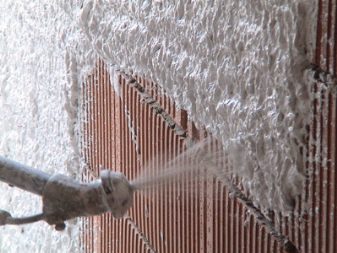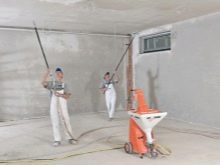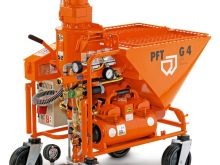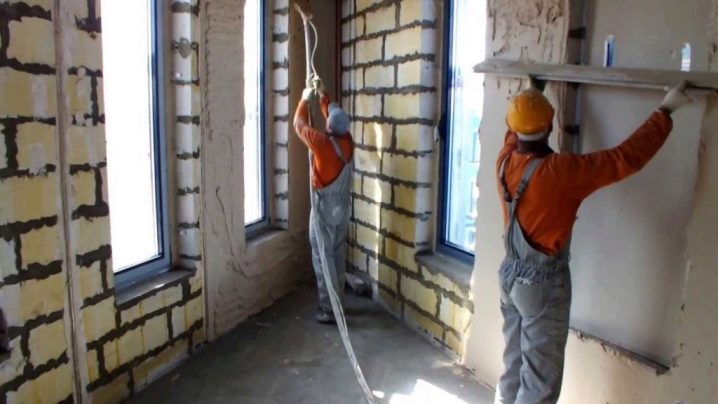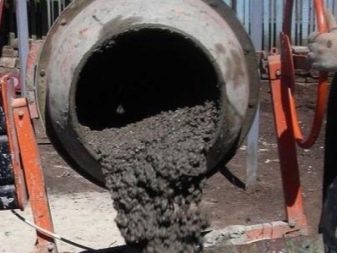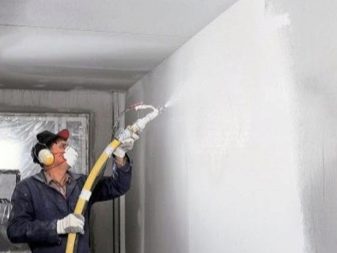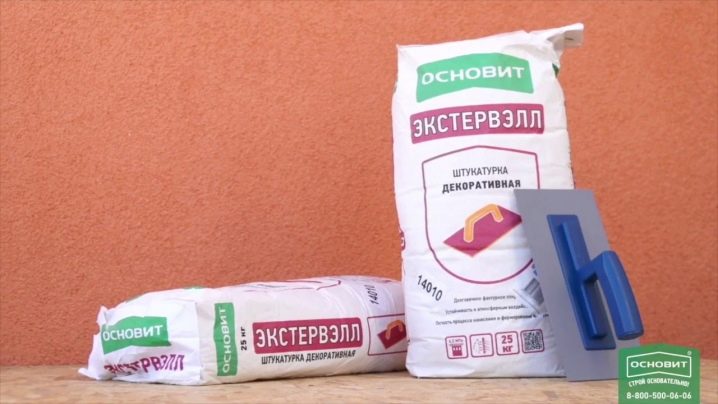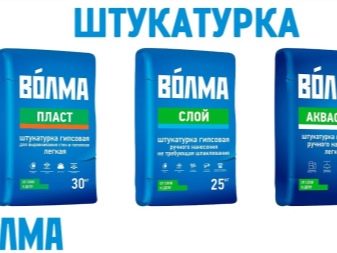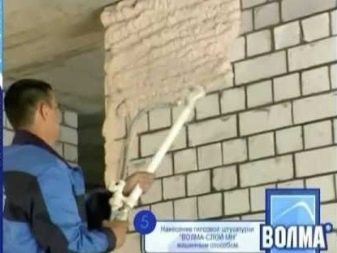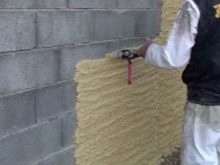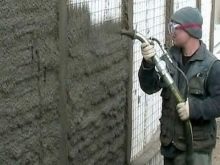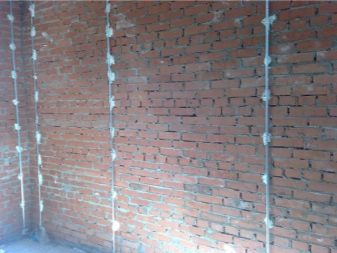Mechanized plaster walls: the pros and cons

Plaster is a universal way of preparing walls for decorative finishing. Today, for such works use a variety of compositions that are applied by hand is quite difficult. To speed up this process, many professionals use automated devices. This approach has many nuances and advantages that you need to know in advance.
Special features
Mechanized plaster is a relatively new method of applying the solution on the wall. It is based on the use of special devices capable of feeding the mixture under a certain pressure through special pipelines.
Technically, this procedure involves the use of various types of engines and compressors.
But the quality of application to the walls mechanically depends on several criteria:
- Adhesion of the surface. Some types of walls can not be covered with plaster without prior preparation. Concrete, brick or walls of various types of gas blocks are great for such works.
- The consistency of the solution. This factor is one of the most important. The mixture should not be too thick, as this will increase the load on the engines and may lead to their failure.
Machine application is much better than manual plastering.
If you use the classic approach, it takes a relatively long time. In this case, the old plaster is already drying, while the new has not yet gained strength.
With the help of automatic application, you can get almost identical as a layer of the solution, which is much easier to work with in the future.
Mechanized plaster is a universal approach that allows you to handle different types of surfaces:
- walls and ceiling;
- door or window slopes;
- decorative arches;
- external walls of buildings.
Machining is a universal way to get a high-quality surface in a relatively short time.
Advantages and disadvantages
Mechanized plasters today are gradually replacing the manual application of solutions. This is due to several significant advantages of such works:
- High performance. The modern market is automatic devices that can use at least 1 cu. m solution per hour. Depending on the layer thickness in one shift, you can easily plaster walls of up to 40-60 m2.
- Quality of application. Plaster "guns" put a solution much better than the usual throwing a bucket. Initially, the surface is almost flat and requires only a small adjustment, which can also be done by automated systems.
- The formation of a strong adhesion of the solution and base. This is achieved due to the uniform distribution of the layers and a uniform feed rate of the solution. With this approach, the solution can penetrate almost all the cracks, filling them almost completely. To achieve this with the help of manual methods is almost impossible.
- Relatively low cost. Apply the mixture can a few people. To achieve such productivity manually, it would be necessary to increase the staff in several times, which would greatly affect the financial costs.
- Reduced plaster costs. This is achieved due to the fact that the mixture evenly falls on the wall. Virtually the entire product is used for its intended purpose, allowing it to cover a much larger area than with the manual approach. According to user reviews using automatic devices, you can reduce consumption by about 1.5 times.
- Relatively low cost of plasters. This indicator may vary depending on the manufacturer and the structure of the wall surface on which the compositions are applied.
- Lack of shpatlevaniye. Cement mortar fills well all the cracks, which eliminates the pre-treatment of the walls.
The use of a mechanical approach when applying plasters allows to simplify repair tasks. But mechanized plaster is not a universal method, since it has several significant disadvantages:
- High cost of equipment. Therefore, in household construction, this method is quite rare. But if you are engaged in this activity professionally, then the tool will pay for itself very quickly. For a one-time plastering is better to hire professionals who already have all the necessary equipment.
- High performance device requires a constant supply of water and mixtures. Therefore, it is desirable to have a water connection so as not to stop the process halfway.
- Strict compliance with the recommendations when preparing mixtures. If you decide to add some impurity yourself, then there is no guarantee that the device will be able to effectively apply the resulting solution.
Modern mechanized devices for applying plasters are a universal solution. This led to their wide distribution in many construction sites, where the processing of walls can be carried out at several points at once.
Mixtures
The main parameter, which determines the quality of the treated surface, are plaster mixtures. Conventionally, they can be divided into dry and wet. The second type of products used by large construction companies.They acquire a ready-made mixture, which they deliver concrete mixers. But the main on the market today are dry mixes, allowing to get the plaster yourself.
Depending on the composition, dry products can be divided into 2 large groups:
- Gypsum plaster. The main connecting element here is ordinary gypsum. Since the material absorbs moisture very well, it is desirable to use it indoors only at low humidity.
A unique feature of gypsum plasters is the high rate of drying.
This allows you to get a high-quality surface for decorative finishes within a few days after application.
The mixtures have high porosity, reducing the consumption of the solution several times as compared with cement compositions. When applied with the help of automatic devices, it is possible to obtain an almost perfectly smooth surface that requires minimal processing.
- Cement-sand plaster. Universal blends that can be applied to virtually any surface. Since the substance is well tolerated by changes in temperature and exposure to water, many use it to finish the facades of houses.
If you are planning to build a pool, this type of plaster will also be the best option.
The disadvantages of this product can be considered a long drying and uneven structure of the upper layer. Therefore, after applying the plaster must be further smoothed to get an even and strong base.
The modern market offers many types of dry and semi-dry mixes. Among all this diversity, there are several popular brands:
"Miners"
Mix on the basis of plaster, differing in high adhesive qualities. It is intended for application to various types of surfaces, among which brick, concrete and foam block are optimal.
Among the positive qualities can distinguish the ability of the solution to pass air and retain heat inside the house.
The manufacturer indicates that the composition can be used as a mixture for finishing.
"Founds"
Another representative of gypsum plasters, perfectly suitable for interior decoration. The fine-grained structure of the components allows the mortar to be applied to the walls with a layer about 1 cm thick.In this case, the consumption of the product does not exceed the value of 9 kg / m Plaster is suitable for processing walls and ceilings.
The material also has high vapor permeability and good thermal insulation characteristics.
Knauf
The company is one of the leaders in the production of mixtures for finishing various surfaces. It should be noted its gypsum plasters, which include various polymer impurities.
Among the features of the material can be distinguished high plasticity, as well as adhesion to various surfaces.
The color scheme of mixtures includes not only gray, but also pink shades.
Volma
One of the leaders of domestic production. It produces high-quality gypsum plaster for mechanized application.
According to technical characteristics, products are almost as good as previous products. Among the features of plaster can distinguish its quick drying.
The manufacturer claims that you can begin to grind the walls after 4 hours after application.
After this treatment, the surface is ready for painting or sticking wallpaper.At the same time, the outer layer is practically indistinguishable from bases covered with special putty compounds.
Please note that practically no one produces cement-based mixtures. Technically, this is not necessary, since getting such a plaster is pretty easy. It is necessary to mix quality sand and cement in certain proportions to get the desired consistency of the solution.
Equipment
Putting plaster is carried out by special mechanized devices. Depending on the method of supplying the solution, they can be divided into 2 main groups:
- Auger machine. The main element of the system is the auger, which is able to capture the solution and move it in a certain direction. These machines can be compared with classic meat grinders. But they are very powerful and powerful. Connect the hose to this system, which is fed to the point of work.
- Pneumatic devices - these are relatively simple constructions. The main tool here is the hopper (ladle), to which the hose with compressed air is connected. Spraying is carried out due to the high velocity of the gas, which pushes the solution through one or more holes.The disadvantage of this device is that the plaster should be prepared separately and immediately in a large volume. Some devices do not differ convenience and practicality. Therefore, their use is justified for living conditions.
All these devices can be used to apply the mixture to walls or floors.
Let us consider in more detail the principle of operation of the screw apparatus:
- Pour the solution into a special mixing compartment. Pay attention that it is possible to use both already prepared products, and separate components. The amount of liquid and all other products must exactly comply with the recommendations of the manufacturer or specialists.
- The system then delivers these components to the inside of the mixer. Inside it is mixing for a certain period of time.
- When the compound is ready, it is captured by the auger and fed into the hose. A high pressure is created there that causes the solution to move to the exit. Getting on the sprayer, the plaster exits at a certain speed and sticks to the base.
Please note that all these processes are fully automated, and the operator is only required to connect a plumbing hose to the system and timely fill the components of the future solution.
Today on the market there are several popular proprietary mechanisms for applying plasters:
- Knauf. Machines of this company are compact. Their main purpose is to apply plaster. But with their help it is possible to carry out and painting.
- Afalina. A bright representative of this brand is the model CMM-30, which can work with various types of solutions. Therefore, it can be used not only to plaster walls or ceilings, but also to flood floors.
- LBM-150 - a small mechanism for plaster, which is recommended to apply if necessary to level the base. Some modifications may also work with paints.
- PFT Ritmo - A modern device that can be used even in small spaces. The system is very versatile, as it is intended not only for plaster, but also for puttying or painting.
Application process
Operating automated machines is a relatively simple operation.
The technology of applying plaster using such devices consists of the following successive stages:
- Surface preparation. Apply the solutions to a relatively clean base.It is advisable to start the preparation with the removal of deck grease, mounting glue and concrete inflows.
- It is important that they do not form protrusions with a height greater than 1 cm. All brick and aerated concrete walls must be additionally primed. For this, experts recommend the use of mixtures of deep penetration.
- If there are many gaps on the surface of the base, then they must be additionally reinforced with metal mesh. This should be done in accordance with the recommendations of experts.
- Installation of beacons. They are needed to get a perfectly flat surface in one plane. Begin this procedure with an assessment of the quality of the wall base. You can learn deviations with the help of a string and a long level.
- Having determined the maximum height of the protrusion on a specific plane, all beacons should be attached. They are fixed using the same solution. To do this, have several point bumps on the surface, to which the lighthouse is attached.
- Adjustment of the equipment. If you are using a regular hopper, then you only need to correctly prepare the solution. In the case of automatic cars,you must first set the required percentage of the mixed components. Some models provide the ability to change and productivity.
- In the next step, connect to the apparatus of the hose with water. It is important to close all the components of the future plaster with mixers in order to speed up the whole procedure.
- Application of the solution. After starting the device, the mixture will start to flow to the outlet valve. The tie should be formed by holding the system at a distance of 20-30 cm from the wall surface. The execution begins with a seal of the corners and the joints, which should be carefully filled with the mixture. It is important that each next layer at the same time overlaps half of the previous one.
- Alignment Immediately after application, the solution should be leveled along the beacons using a long rule. After 30-50 minutes after that, you can start leveling with different types of graters. They allow you to get a smooth, but not smooth surface. If you need a very high quality, then the frozen solution should be additionally putty.
Please note that this approach is very often used for cement plasters.Gypsum solutions are more plastic and practical. After grouting, these surfaces can be immediately painted or coated with other finishing materials.
Tips
The quality of plaster obtained with the help of mechanical devices, has a high performance.
To achieve these characteristics, you should follow a few simple rules:
- Plaster walls can only be in rooms where the temperature does not fall below +5 degrees. Therefore, in winter, such tasks are carried out only in heated premises, where it is possible to control the microclimate.
- Apply the mixture from top to bottom. Please note that manually these operations are performed in reverse. If external facades are being machined, then they need to be further strengthened with a metal reinforcing mesh.
- To level a coupler under painting or wall-paper, it is necessary to process and putty plaster in due time. It is desirable to do this 2 hours after applying the mixture. To simplify the task, pre-moisten the material with water from the dispenser and let it soak. This will soften the solution and allow it to be distributed evenly and easily.
- Use for work only high-quality mixture of well-known manufacturers. Bole cheap products do not always show themselves at a high level.
The technology of applying mechanized plaster is quite simple and requires only the observance of rules and accuracy. Important here is the choice of a quality tool that allows you to apply the plaster in a convenient way, and follow the precise steps of the process.
If you take into account all the recommendations, the coating applied by mechanical means will be of high quality and durable.
How the plastering of the walls in a mechanized way is performed can be seen below.





